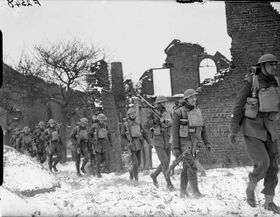Operation Surrogate
| Operation Surrogate Kurosawa's March to the North | |||||||
|---|---|---|---|---|---|---|---|
| Part of the Third Joyonghean-Quenminese War of the Second Europan War | |||||||
 Rubrumian infantry near Musan, December 1944 | |||||||
| |||||||
| Belligerents | |||||||
| Commanders and leaders | |||||||
| Strength | |||||||
|
Initial: 950,000 By May 1945: 1,924,500 |
Initial: 1,750,000 By May 1945: 750,000 | ||||||
| Casualties and losses | |||||||
|
165,978 casualties
490 aircraft |
397,978 casualties
782 aircraft | ||||||
Operation Surrogate, or famously known as "Kurosawa's March to the North" was a campaign that spanned for 7 months which involved nearly 2 million Allied troops throughout the campaign. It was to be the biggest campaign ever fought during the Third Joyonghean-Quenminese War. The grand strategy came largely from Rubrumian General Harry Kurosawa, who realised that if the Allies could not reach the Quenminese colony of Churuongchandat by 1945, the war would last for 5 more years. And with Grand General Cheon Sang-ji dealing with the Imperial forces in Western Joyonghea, Kurosawa sought to use the Eastern region of Joyonghea as a route to hasten the Allied advance to the north. From here, he would be able to cross the border just before 1945.
His forces followed a scorched earth policy, destroying military and industrial complex, disrupting supply and transportation routes between Quenmin-occupied Joyonghea and Churuongchandat. The operation greatly costed the Imperials the capability to fight the war longer and helped lead to its eventual defeat during the Hyesong Gap. Kurosawa's strategies and decision to operate further into enemy lines through the use of quick movement manoeuvres is regarded by many historians as the basis for a large-scale asymmetric and modern warfare.
The advance subsequently ended during the middle stages of the Battle of the Hyesong Gap, which saw nearly 750,000 Imperial troops, almost 6 Imperial army groups to be surrounded on all sides. This was to be the largest encirclement in military history.
Background
Preparations
Order of Battle
Allied Forces
- 1st Zanarkian-Joyonghean Army Group
- 1st Conglomerate
- Joyonghean Imperial Regiment of Guards
- 1st Battalion, Saengmyeong Guards
- 1st Battalion, Jejunom Guards
- 1st Battalion, Pobaek Guards
- 1st Battalion, Jurchen Guards
- Second Joyonghean Army
- 7th Area Division
- 8th Area Division
- 10th Area Division
- 2nd Zanarkian-Joyonghean Infantry Division
- Zanarkian-Joyonghean Sapper Division
- Third Joyonghean Army
- 4th Area Division
- 21st Area Division
- 1st Zanarkian-Joyonghean Infantry Division
- 3rd Zanarkian-Joyonghean Infantry Division
- Sixth Joyonghean Army
- 20th Area Division
- 22nd Area Division
- 1st Zanarkian-Joyonghean Armored Brigade
- 2nd Zanarkian-Joyonghean Armored Brigade
- 1st Teulabian Supplementary Brigade
- 1st Teulabian Infantry Regiment
- 2nd Teulabian Infantry Regiment
- 1st Teulabian Battery
- Joyonghean Imperial Regiment of Guards
- Fifth Zanarkian Imperial Force
- XX Zanarkian Corps
- VIII Zanarkian Corps
- X Zanarkian Corps
- New Akiba Joyonghea Expeditionary Corps
- Bikanel Force
- 1st Conglomerate
- Third Rubrumian Army
- General Headquarters
- IV Rubrumian Corps
- V Rubrumian Corps
- VIII Nihhonese Corps (Artillery & other Support Services)
- IX Jutland-Gimlian Corps
- General Headquarters
- Lucis 11th Army